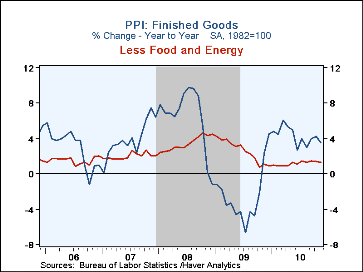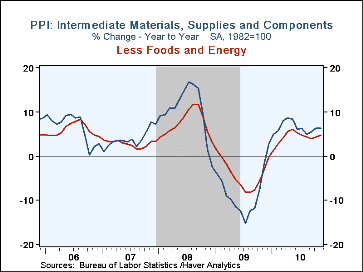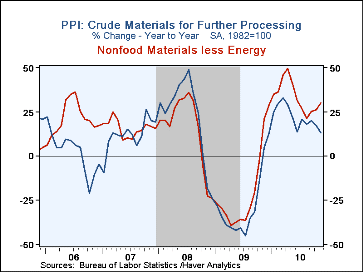 Global| Dec 14 2010
Global| Dec 14 2010U.S. PPI Strengthens As Energy & Food Costs Jump
by:Tom Moeller
|in:Economy in Brief
Summary
The U.S. Producer Price Index for finished goods surged 0.8% last month, double the 0.4% gains during the prior three. The rise outpaced Consensus expectations for a 0.6% increase. Higher energy prices were behind much of the strength [...]
 The U.S. Producer Price Index for finished goods surged 0.8% last month,
double the 0.4% gains during the prior three. The rise outpaced Consensus
expectations for a 0.6% increase. Higher energy prices were behind much of the
strength while food prices recovered after an October dip. The PPI less food
& energy rose a moderate 0.3% after the 0.6% October decline. Consensus
expectations were for a 0.2% rise.
The U.S. Producer Price Index for finished goods surged 0.8% last month,
double the 0.4% gains during the prior three. The rise outpaced Consensus
expectations for a 0.6% increase. Higher energy prices were behind much of the
strength while food prices recovered after an October dip. The PPI less food
& energy rose a moderate 0.3% after the 0.6% October decline. Consensus
expectations were for a 0.2% rise.
Energy prices led last month's pricing strength with a 2.1% jump (9.5% y/y) as gasoline prices increased 4.7% (11.8% y/y). Since the late-2008 low, gasoline prices have roughly doubled. Home heating oil prices also were strong, posting a 7.0% increase (17.2% y/y). These gains, however, were offset by monthly declines in natural gas prices (-2.0% y/y) as well as electricity prices (+3.4% y/y). Food prices strengthened again. The 1.0% increase (4.1% y/y) reflected strength in egg (12.2%), beef & veal (12.7% y/y) and dairy product (10.2% y/y) prices.
Core finished consumer goods prices rose 0.3% (2.0% y/y) and recovered most of the 0.4% October decline. Passenger car prices jumped 1.7% (-1.9% y/y). Capital goods prices inched up 0.2% (+0.3% y/y) after a sharp 0.8% October fall as light truck prices nudged up 0.3% (-1.0% y/y).
Intermediate goods prices jumped another 1.1% as energy prices surged 2.8% (11.3% y/y). That increase was accompanied by a 1.9% surge in food prices (7.5% y/y). Core-intermediate prices also were strong with a 0.7% gain (4.7% y/y). Earlier strength in crude goods pricing eased to a 0.6% gain due to a 1.3% decline in energy prices (-2.4% y/y). Crude food prices rose another 0.7% (21.3% y/y). Continuing to reflect strength in the industrial sector, core crude prices posted a 3.1% (30.2% y/y) jump that was led by higher iron & steel scrap (43.7% y/y), aluminum base scrap (30.7% y/y) and copper scrap (27.1% y/y) prices.
The PPI data are contained in Haver's USECON database with further detail in PPI and PPIR.
The Breadth of Disinflation from the Federal Reserve Bank of San Francisco is available here.
| Producer Price Index (%) | Nov | Oct | Sept | Year Ago | 2009 | 2008 | 2007 |
|---|---|---|---|---|---|---|---|
| Finished Goods | 0.8 | 0.4 | 0.4 | 3.5 | -2.5 | 6.4 | 3.9 |
| Energy | 2.1 | 3.7 | 0.5 | 9.5 | -17.6 | 14.1 | 6.8 |
| Food | 1.0 | -0.1 | 1.2 | 4.1 | -1.4 | 6.8 | 6.6 |
| Less Food & Energy | 0.3 | -0.6 | 0.1 | 1.3 | 2.6 | 3.4 | 2.0 |
| Intermediate Goods | 1.1 | 1.2 | 0.5 | 6.3 | -8.4 | 10.3 | 4.0 |
| Less Food & Energy | 0.7 | 0.6 | 0.2 | 4.7 | -4.2 | 7.4 | 2.8 |
| Crude Materials | 0.6 | 4.3 | -0.5 | 13.0 | -30.3 | 21.4 | 11.9 |
| Less Food & Energy | 3.1 | 2.1 | 5.5 | 30.2 | -23.5 | 14.8 | 15.6 |
Tom Moeller
AuthorMore in Author Profile »Prior to joining Haver Analytics in 2000, Mr. Moeller worked as the Economist at Chancellor Capital Management from 1985 to 1999. There, he developed comprehensive economic forecasts and interpreted economic data for equity and fixed income portfolio managers. Also at Chancellor, Mr. Moeller worked as an equity analyst and was responsible for researching and rating companies in the economically sensitive automobile and housing industries for investment in Chancellor’s equity portfolio. Prior to joining Chancellor, Mr. Moeller was an Economist at Citibank from 1979 to 1984. He also analyzed pricing behavior in the metals industry for the Council on Wage and Price Stability in Washington, D.C. In 1999, Mr. Moeller received the award for most accurate forecast from the Forecasters' Club of New York. From 1990 to 1992 he was President of the New York Association for Business Economists. Mr. Moeller earned an M.B.A. in Finance from Fordham University, where he graduated in 1987. He holds a Bachelor of Arts in Economics from George Washington University.








